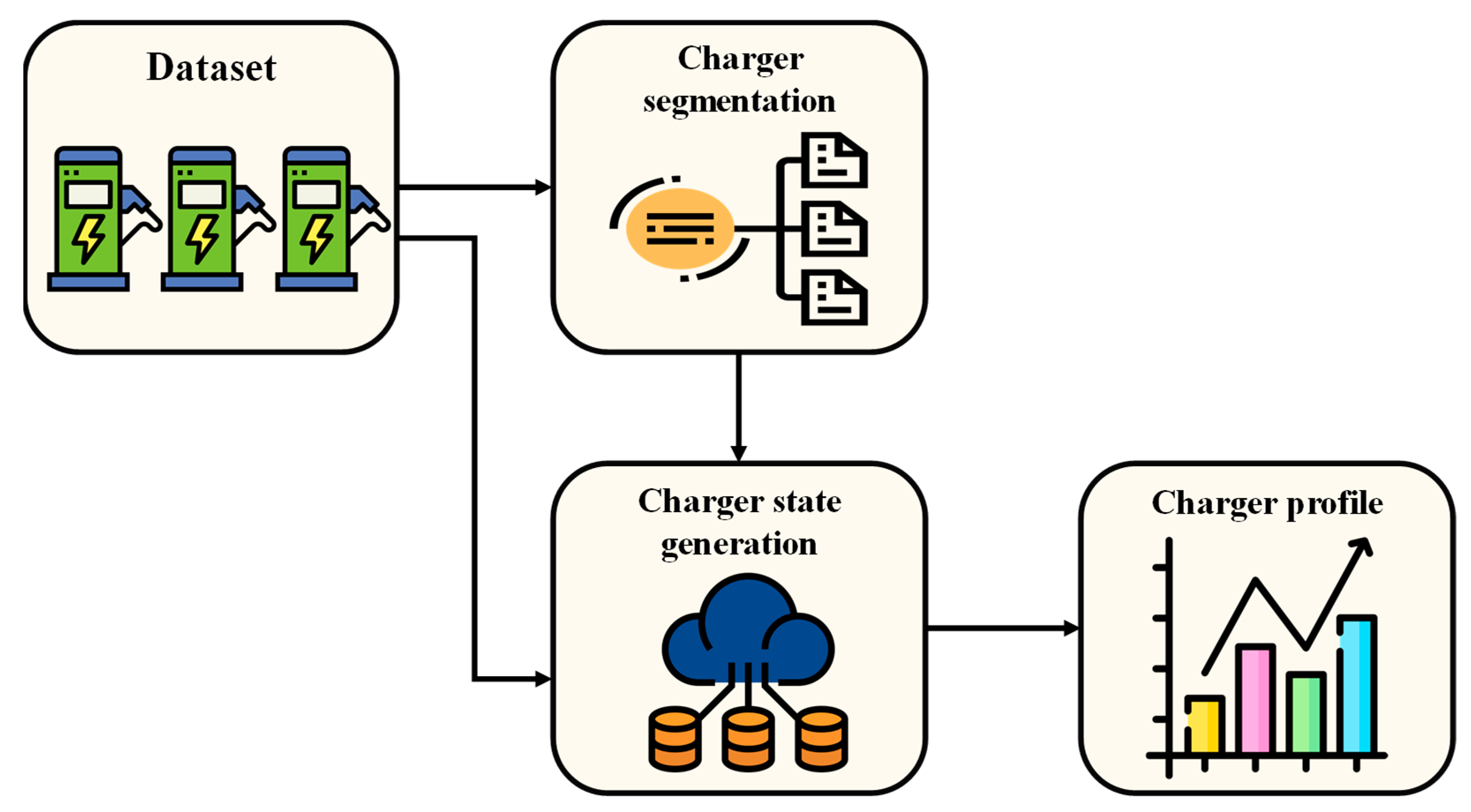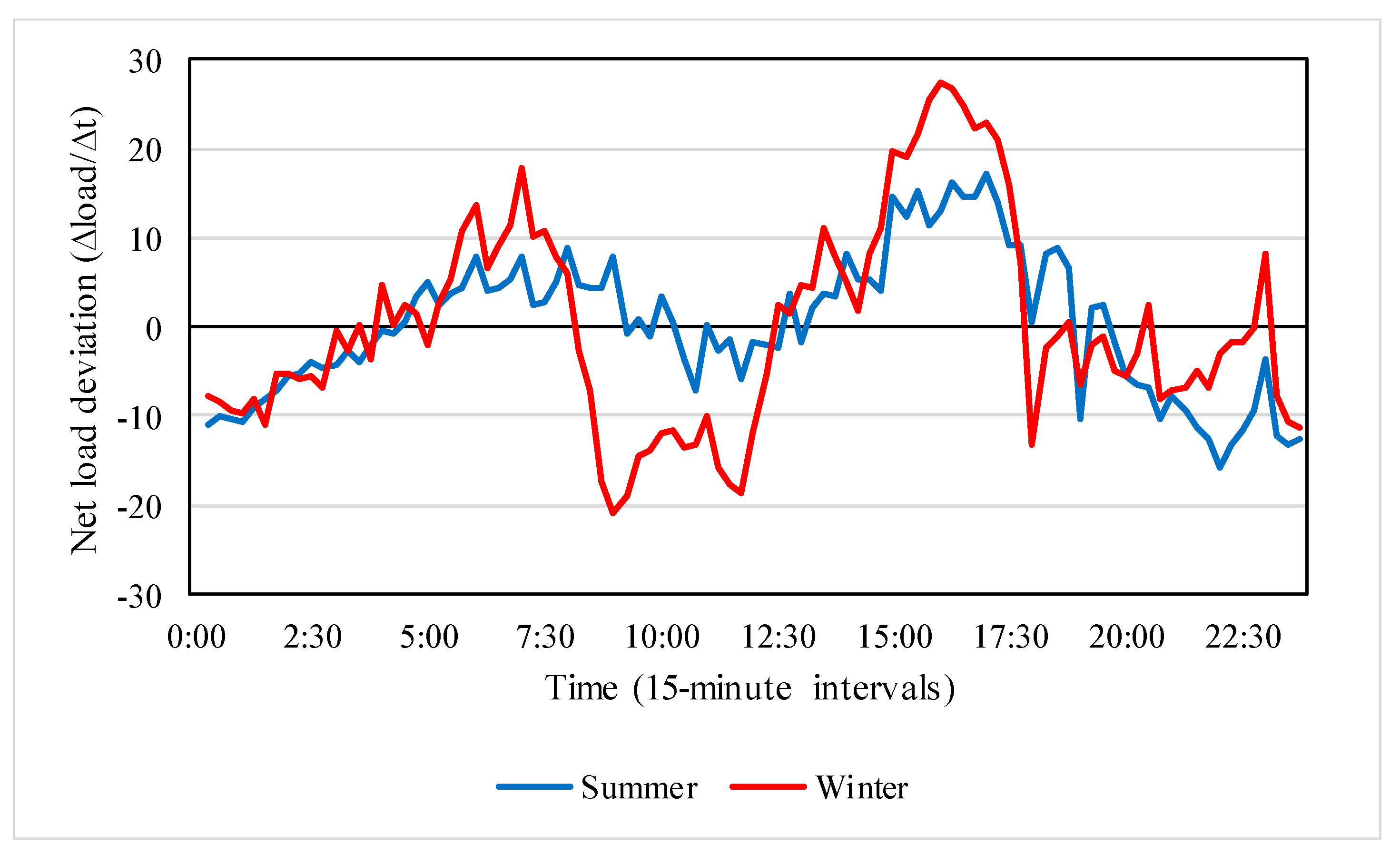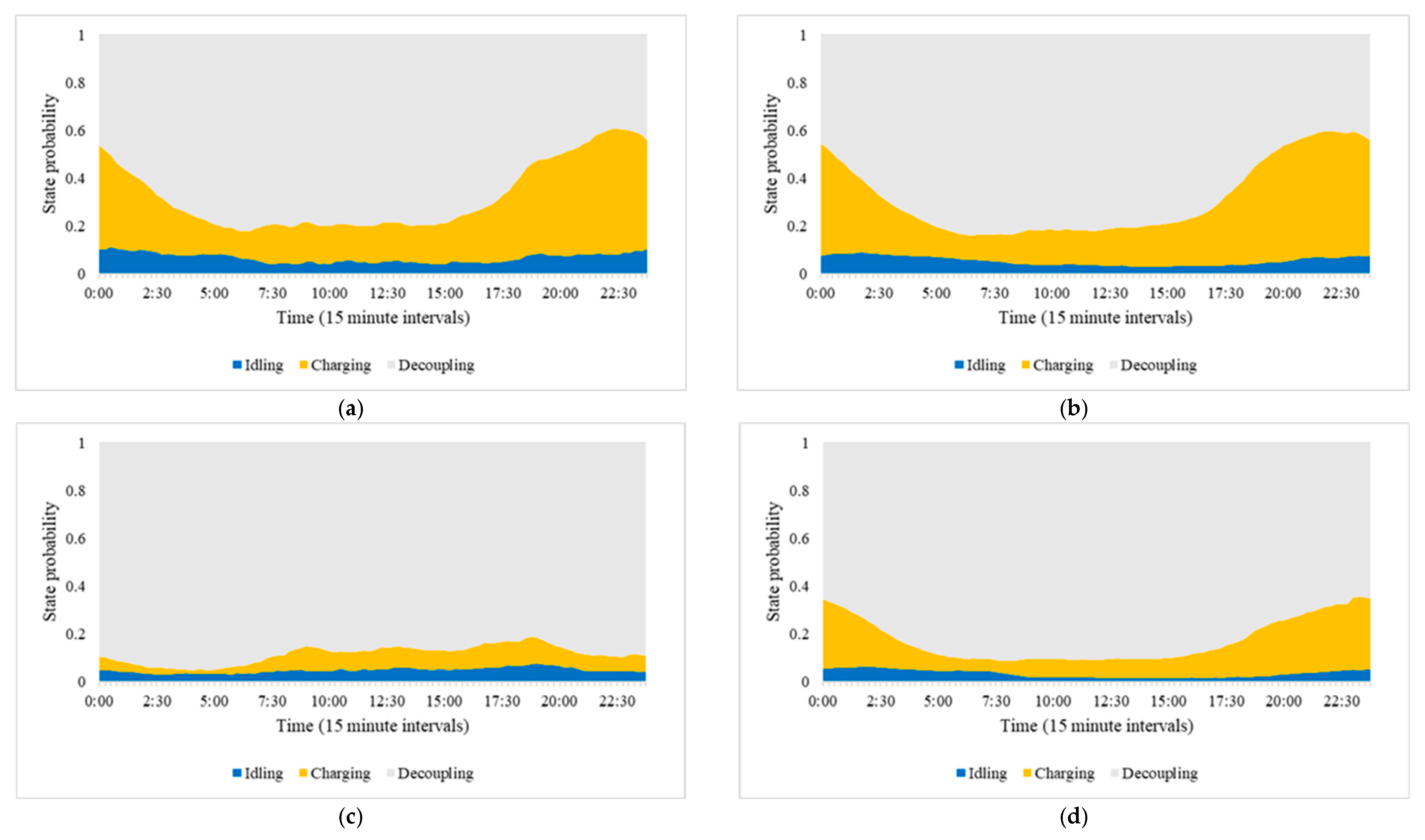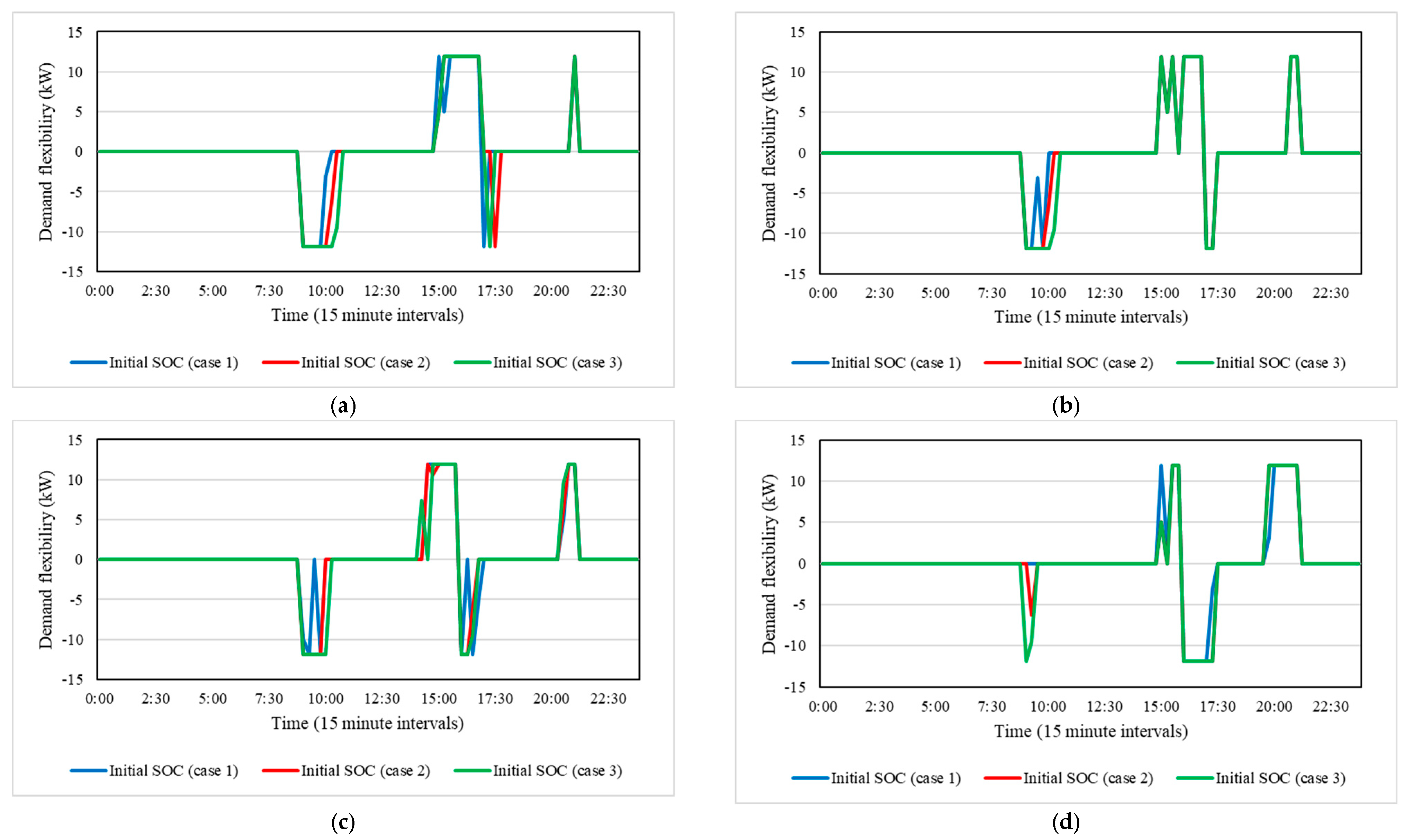Techno-Probabilistic Flexibility Assessment of EV2G Based on Chargers’ Historical Records
Abstract
1. Introduction
- -
- A new probabilistic representative charger state profile derivation model is proposed. The robustness of the segmented charger groups’ profile derivation process is improved through the analysis of the multi-probability model, which consists of the real-time charger state occurrence probability and the state transition probability between each unit time.
- -
- The proposed framework quantitatively estimates flexibility through the well-structured virtual EV2G optimal operation model. Based on the model, technical EV2G flexibility is confirmed to contribute to the system in time periods for supply–demand stabilization according to data-based statistical state-of-charge (SoC) scenarios.
- -
- The results of the technical flexibility assessment validate the EV2G contribution effect within a microgrid unit in a multi-perspective manner.
2. Proposed Framework
2.1. Charger Profile Generation Model (CPGM)
2.1.1. EV Charger Segmentation
2.1.2. TVMC-Based State Generation
2.2. Virtual EV2G Flexibility Model (VEFM)
2.2.1. Ramp-Up/Down Periods and Ramp Score Setting
2.2.2. Objective Function
2.2.3. SoC Management Constraints
3. Test System and Assumptions
- -
- Charger records included all events within the period from 1 January 2019 to 31 December 2019. It was assumed that the EV users’ coupling behaviors for charging were independent of the season and weather influence. In addition, it was assumed that the sampled chargers could be representative of all the chargers installed in the whole grid of Jeju. The data were provided by the Korea Electric Power Company and included the usage history of 196 chargers in residential areas and 199 chargers in public areas. Information included the charger type, connection start time, connection end time, and charge amount.
- -
- The entire system net load data of Jeju, which was measured in 2021, was applied to set the ramp-up/down periods. The net load was calculated as the difference between system demand and renewable energy generation for summer and winter. It was assumed that the same net load pattern for each time period was shown even during the data-driven charger–EV coupling events.
- -
- In the TVMC analysis for charger state profile generation, the reference time for the initial state occurrence was fixed at the first time interval. It was assumed that a converged single profile was derived regardless of the setting change of the initial state occurrence time through repeated simulations with a very large number.
- -
- To solve the optimization problem in the VEFM, mixed integer linear programming was applied. The calculation was performed using MATLAB 2024a with the Gurobi optimizer solver.
4. Results and Discussions
4.1. Technical Flexibility Assessment Results
4.1.1. CPGM Results
4.1.2. VEFM Results
4.2. Interpretation of EV2G Flexibility Contribution Effect by Perspectives
4.2.1. Technical Perspective
4.2.2. Economic Perspective
4.2.3. Environmental Perspective
5. Conclusions
Author Contributions
Funding
Data Availability Statement
Conflicts of Interest
References
- The Paris Agreement. Available online: https://unfccc.int/process-and-meetings/the-paris-agreement/the-paris-agreement (accessed on 27 March 2025).
- COP26: What Happened, What Does This Mean, and What Happens Next? Available online: https://www.chathamhouse.org/sites/default/files/2021-11/2021-11-15-COP26-what-happened-summary-Aberg-et-al.pdf (accessed on 27 March 2025).
- EU Taxonomy for Sustainable Activities. Available online: https://ec.europa.eu/info/business-economy-euro/banking-and-finance/sustainable-finance/eu-taxonomy-sustainable-activities_en (accessed on 27 March 2025).
- Strbac, G. Demand side management Benefits and challenges. Energy Policy 2008, 36, 4419–4426. [Google Scholar] [CrossRef]
- Breeze, P. Power Generation Technologies, 3rd ed.; Newnes; Elsevier Ltd.: Amsterdam, The Netherlands, 2019; pp. 219–250. [Google Scholar]
- Innovation Operation of Pumped Hydropower Storage: Innovation Landscape Brief. Available online: https://www.irena.org/-/media/Files/IRENA/Agency/Publication/2020/Jul/IRENA_Innovative_PHS_operation_2020.pdf (accessed on 27 March 2025).
- Flexibility in Conventional Power Plant: Innovation Landscape Brief. Available online: https://www.irena.org/-/media/Files/IRENA/Agency/Publication/2019/Sep/IRENA_Flexibility_in_CPPs_2019.pdf?la=en&hash=AF60106EA083E492638D8FA9ADF7FD099259F5A1 (accessed on 27 March 2025).
- Gharehpetian, G.B.; Mousavi, M. Distributed Generation Systems: Design, Operation and Grid Integration, 1st ed.; Butterworth-Heinemann: Oxford, UK, 2017; pp. 333–368. [Google Scholar]
- Kong, Y.; Kong, Z.; Liu, Z.; Wei, C.; Zhang, J.; An, G. Pumped storage power stations in China: The past, the present, and the future. Ren. Sustain. Energy Rev. 2017, 71, 720–731. [Google Scholar] [CrossRef]
- Pumped Storage Hydropower: Benefits for Grid Reliability and Integration of Variable Renewable Energy. Available online: https://publications.anl.gov/anlpubs/2014/12/106380.pdf (accessed on 27 March 2025).
- Lee, H.G.; Kim, G.-G.; Bhang, B.G.; Kim, D.K.; Park, N.; Ahn, H.-K. Design Algorithm for Optimum Capacity of ESS Connected With PVs Under the RPS Program. IEEE Access 2018, 6, 45899–45906. [Google Scholar] [CrossRef]
- Sun, Y. Advances in Power and Energy Engineering: Proceedings of the 8th Asia-Pacific Power and Energy Engineering Conference; CRC Press: Suzhou, China, 2016; pp. 91–96. [Google Scholar]
- Karkour, S.; Ichisugi, Y.; Abeynayaka, A.; Itsubo, N. External-Cost Estimation of Electricity Generation in G20 Countries: Case Study Using a Global Life-Cycle Impact-Assessment Method. Sustainability 2020, 12, 2002. [Google Scholar] [CrossRef]
- Benefits of Demand Response in Electricity Markets and Recommendations for Achieving Them. Available online: https://www.energy.gov/sites/prod/files/oeprod/DocumentsandMedia/DOE_Benefits_of_Demand_Response_in_Electricity_Markets_and_Recommendations_for_Achieving_Them_Report_to_Congress.pdf (accessed on 27 March 2025).
- Micari, S.; Napoli, G. Electric Vehicles for a flexible energy system: Challenges and opportunities. Energies 2024, 17, 5614. [Google Scholar] [CrossRef]
- Secchi, M.; Barchi, G.; Macii, D.; Petri, D. Smart electric vehicles charging with centralised vehicle-to-grid capability for net-load variance minimisation under increasing EV and PV penetration levels. Sustain. Energy Grids Netw. 2023, 35, 101120. [Google Scholar] [CrossRef]
- Fachrizal, R.; Ramadhani, U.H.; Munkhammar, J.; Widén, J. Combined PV–EV hosting capacity assessment for a residential LV distribution grid with smart EV charging and PV curtailment. Sustain. Energy Grids Netw. 2021, 26, 100445. [Google Scholar] [CrossRef]
- Demirci, A.; Tercan, S.M.; Ahmed, E.E.; Cali, U.; Nakir, I. A novel electric vehicle charging management with dynamic active power curtailment framework for PV-rich prosumers. IEEE Access 2024, 12, 120239–120249. [Google Scholar] [CrossRef]
- Lei, X.; Yu, H.; Zhong, J.; Jia, Y.; Shao, Z.; Jian, L. Exploring electric vehicle’s potential as capacity reservation through V2G operation to compensate load deviation in distribution systems. J. Clean. Prod. 2024, 451, 141997. [Google Scholar] [CrossRef]
- Demand-Side Flexibility for Power Sector Transformation. Available online: https://www.irena.org/-/media/Files/IRENA/Agency/Publication/2019/Dec/IRENA_Demand-side_flexibility_2019.pdf (accessed on 27 March 2025).
- Howlader, H.O.R.; Sediqi, M.M.; Ibrahimi, A.M.; Senjyu, T. Optimal Thermal Unit Commitment for Solving Duck Curve Problem by Introducing CSP, PSH and Demand Response. IEEE Access 2018, 6, 4834–4844. [Google Scholar] [CrossRef]
- Lotfi, M.; Almeida, T.; Javadi, M.; Osório, G.J.; Catalão, J.P. Coordinated operation of electric vehicle parking lots and smart homes as a virtual power plant. In Proceedings of the 2020 IEEE International Conference on EEEIC/I&CPS Europe, Madrid, Spain, 9–12 June 2020; pp. 1–6. [Google Scholar]
- Almeida, T.; Lotfi, M.; Javadi, M.; Osório, G.J.; Catalão, J.P. Economic Analysis of Coordinating Electric Vehicle Parking Lots and Home Energy Management Systems. In Proceedings of the 2020 IEEE International Conference on EEEIC/I&CPS Europe, Madrid, Spain, 9–12 June 2020; pp. 1–6. [Google Scholar]
- MansourLakouraj, M.; Shams, M.H.; Niaz, H.; Liu, J.J.; Javadi, M.S.; Catalão, J.P. Optimal Coordination of Hydrogen Vehicle Stations and Flexible Resources in Microgrids. In Proceedings of the 2021 IEEE International Conference on EEEIC/I&CPS Europe, Bari, Italy, 7–10 September 2021; pp. 1–6. [Google Scholar]
- Lotfi, M.; Almeida, T.; Javadi, M.S.; Osório, G.J.; Monteiro, C.; Catalão, J.P. Coordinating energy management systems in smart cities with electric vehicles. Appl. Energy 2022, 307, 118241. [Google Scholar] [CrossRef]
- Jordehi, A.R.; Javadi, M.S.; Catalão, J.P. Day-ahead scheduling of energy hubs with parking lots for electric vehicles considering uncertainties. Energy 2021, 229, 120709. [Google Scholar] [CrossRef]
- Osório, G.J.; Lotfi, M.; Gough, M.; Javadi, M.; Espassandim, H.M.; Shafie-khah, M.; Catalão, J.P. Modeling an electric vehicle parking lot with solar rooftop participating in the reserve market and in ancillary services provision. J. Clean. Prod. 2021, 318, 128503. [Google Scholar] [CrossRef]
- Lee, H.; Kim, H.; Kim, H.; Kim, H. Optimal Vehicle-to-Grid Charge Scheduling for Electric Vehicles Based on Dynamic Programming. Energies 2025, 18, 1109. [Google Scholar] [CrossRef]
- Shahriar, S.; Al-Ali, A.R.; Osman, A.H.; Dhou, S.; Nijim, M. Prediction of EV Charging Behavior Using Machine Learning. IEEE Access 2021, 9, 111576–111586. [Google Scholar] [CrossRef]
- Flammini, M.G.; Prettico, G.; Julea, A.; Fulli, G.; Mazza, A.; Chicco, G. Statistical characterisation of the real transaction data gathered from electric vehicle charging stations. Elec. Power Syst. Res. 2019, 166, 136–150. [Google Scholar] [CrossRef]
- Sadeghianpourhamami, N.; Refa, N.; Strobbe, M.; Develder, C. Quantitive analysis of electric vehicle flexibility: A data-driven approach. Int. J. Electr. Power Energy Syst. 2018, 95, 451–462. [Google Scholar] [CrossRef]
- Chen, Z.; Zhang, Z.; Zhao, J.; Wu, B.; Huang, X. An analysis of the charging characteristics of electric vehicles based on measured data and its application. IEEE Access 2018, 6, 24475–24487. [Google Scholar] [CrossRef]
- Zhang, X.; Chan, K.W.; Li, H.; Wang, H.; Qiu, J.; Wang, G. Deep-learning-based probabilistic forecasting of electric vehicle charging load with a novel queuing model. IEEE Trans. Cybern. 2020, 51, 3157–3170. [Google Scholar] [CrossRef]
- Nyamayoka, L.T.E.; Masisi, L.; Dorrell, D.; Wang, S. Techno-Economic Feasibility and Optimal Design Approach of Grid-Connected Hybrid Power Generation Systems for Electric Vehicles Battery Swapping Station. Energies 2025, 18, 1208. [Google Scholar] [CrossRef]
- Lami, B.; Alsolami, M.; Alferidi, A.; Slama, S.B. A Smart Microgrid Platform Integrating AI and Deep Reinforcement Learning for Sustainable Energy Management. Energies 2025, 18, 1157. [Google Scholar] [CrossRef]
- Aghabozorgi, S.; Shirkhorshidi, A.S.; Wah, T.Y. Time-series clustering—A decade review. Inf. Syst. 2015, 53, 16–38. [Google Scholar] [CrossRef]
- Baek, K.; Kim, S.; Lee, E.; Cho, Y.; Kim, J. Data-driven demand flexibility of segmented electric vehicle chargers in the Korean residential sector. Energies 2021, 14, 866. [Google Scholar] [CrossRef]
- Baek, K.; Lee, E.; Kim, J. Resident behavior detection model for environment responsive demand response. IEEE Trans. Smart Grid 2021, 12, 3980–3989. [Google Scholar] [CrossRef]











| Installation Location | Case | Initial SoC |
|---|---|---|
| Residential area (1) | 57.9 | |
| 73.9 | ||
| 90.71 | ||
| Residential area (2) | 61.15 | |
| 76.85 | ||
| 92.55 | ||
| Public areas | 62.45 | |
| 77.54 | ||
| 92.63 |
| Installation Area | Number of Clusters | |
|---|---|---|
| Residential areas | (a) | 6 |
| (b) | 36 | |
| (c) | 109 | |
| (d) | 20 | |
| Public areas | (a) | 5 |
| (b) | 54 | |
| (c) | 33 | |
| (d) | 21 | |
Disclaimer/Publisher’s Note: The statements, opinions and data contained in all publications are solely those of the individual author(s) and contributor(s) and not of MDPI and/or the editor(s). MDPI and/or the editor(s) disclaim responsibility for any injury to people or property resulting from any ideas, methods, instructions or products referred to in the content. |
© 2025 by the authors. Licensee MDPI, Basel, Switzerland. This article is an open access article distributed under the terms and conditions of the Creative Commons Attribution (CC BY) license (https://creativecommons.org/licenses/by/4.0/).
Share and Cite
Ko, K.; Lee, E.; Baek, K. Techno-Probabilistic Flexibility Assessment of EV2G Based on Chargers’ Historical Records. Energies 2025, 18, 2031. https://doi.org/10.3390/en18082031
Ko K, Lee E, Baek K. Techno-Probabilistic Flexibility Assessment of EV2G Based on Chargers’ Historical Records. Energies. 2025; 18(8):2031. https://doi.org/10.3390/en18082031
Chicago/Turabian StyleKo, Kabseok, Eunjung Lee, and Keon Baek. 2025. "Techno-Probabilistic Flexibility Assessment of EV2G Based on Chargers’ Historical Records" Energies 18, no. 8: 2031. https://doi.org/10.3390/en18082031
APA StyleKo, K., Lee, E., & Baek, K. (2025). Techno-Probabilistic Flexibility Assessment of EV2G Based on Chargers’ Historical Records. Energies, 18(8), 2031. https://doi.org/10.3390/en18082031






